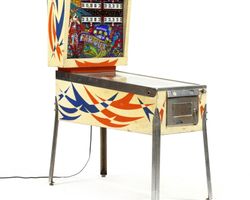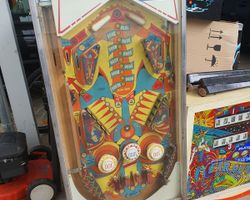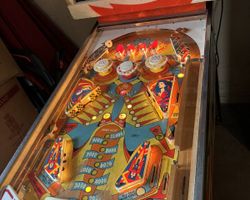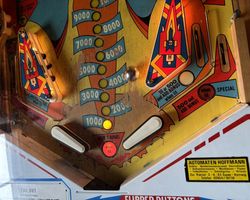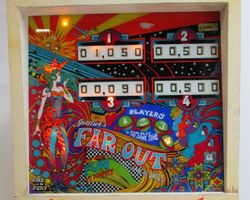Far Out
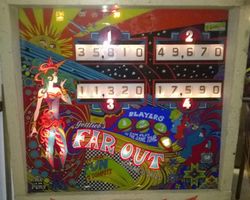
Average Prices: USD $200 to $900
Produced: October, 1974
Production Run: 4,820 units
Machine Type: Electro-mechanical
Players: 4
Design by: Ed Krynski
Art by: Gordon Morison
Gottlieb's "Far Out," released in December 1974, emerged from an era defined by the distinctive aesthetic and mechanical ingenuity of electro-mechanical pinball machines. D. Gottlieb & Co. had long established itself as a prominent manufacturer in the pinball industry, consistently producing games that captivated players in arcades and public spaces. "Far Out" continued this tradition, designed by the prolific Ed Krynski, with the vibrant and era-specific artwork by Gordon Morison. This four-player pinball machine, model number 365, shares its design lineage with Gottlieb's two-player "Out of Sight," a common practice for manufacturers to offer variations for different operator needs. With a production run of 4,820 units, "Far Out" achieved a substantial market presence, solidifying its place as a representative title from the mid-1970s. Its development process, like many EM machines, relied on robust mechanical components and intricate wiring, a testament to the engineering prowess of the time. The game's theme, steeped in the "groovy" and psychedelic imagery popular during the 1970s, instantly transports players to a specific cultural moment, making it an intriguing piece of pinball history.
Signature Features and Design
The visual appeal of the "Far Out" pinball machine is immediately apparent, largely due to Gordon Morison's distinct artwork. The backglass, in particular, showcases a kaleidoscope of colors and stylized figures that embody the psychedelic movement of the 1970s. This vibrant aesthetic extends to the playfield, contributing to an immersive theme that stands out even among its contemporaries. Beyond the striking visuals, the mechanical features define the gameplay experience. Central to "Far Out" are its ten drop targets, arranged in two banks of five. These targets are not merely obstacles; they are the primary objectives, designed to be satisfyingly responsive when hit. A key design element allows individual drop targets to light up for significantly higher point values, such as a coveted 5,000-point target, providing focused goals for players.
Further enhancing the game's dynamic flow are several other notable features. Three pop bumpers strategically positioned on the playfield keep the ball in motion and contribute to rapid scoring opportunities. Two slingshots at the lower part of the playfield offer reactive deflection, adding unpredictability. A right ball return gate is a desirable feature, sending the ball back to the shooter lane after passing through it, offering a momentary reprieve and a chance to regroup. Perhaps one of the most appreciated additions is the left outlane ball kicker. This mechanism can save a ball that would otherwise drain, injecting an element of chance and extending gameplay, a feature often welcomed by players hoping to maximize their scores. The scoring itself is displayed on classic mechanical reels, adding to the authentic electro-mechanical experience with their satisfying click as points accumulate.
Playfield and Mechanics
The playfield layout of "Far Out" is a testament to Gottlieb's design philosophy of the era, focusing on clear objectives and satisfying target interaction. At its heart are the two prominent five-bank drop target sets, strategically placed to be the primary focus of player shots. Above these targets, three pop bumpers create a chaotic scoring zone, rewarding players for accurate shots that feed into this area. Flanking the lower playfield are two responsive slingshots, positioned to redirect the ball with force towards the upper regions or back into play. Two standup targets are also integrated, offering additional scoring opportunities and contributing to bonus accumulation. The layout facilitates a flow where players are constantly challenged to aim for the drop targets, either directly or via rebounds from the pop bumpers.
The design philosophy behind "Far Out" prioritizes direct engagement with targets, a common approach for EM machines where complex rulesets were not yet prevalent. Players are encouraged to systematically clear the drop targets, which in turn activates bonus multipliers and sets up higher scoring potential. The playfield's aesthetic, while perhaps less intricate than Morison's backglass, maintains the overall psychedelic theme with its color palette and graphic elements, ensuring visual cohesion. Lighting cues on the playfield effectively communicate which targets are lit for higher values or indicate bonus progression, guiding the player's strategy. The combination of these mechanical features and the visual design creates an engaging play experience that is both accessible for new players and challenging for those seeking to master target accuracy.
Gameplay Dynamics
"Far Out" offers a compelling gameplay experience centered on its core mechanics and scoring opportunities. The primary objective revolves around knocking down the ten drop targets. Each target contributes to the player's score, and clearing an entire bank of five targets is key to maximizing points. A notable aspect of the scoring system is the ability of individual drop targets to light up for increased value, with the coveted 5,000-point target providing a significant score boost for precise shots. Beyond individual target hits, successfully clearing the drop target banks contributes to the end-of-ball bonus, with the potential for a double bonus, incentivizing players to prioritize these targets throughout their ball.
The progression of a game on "Far Out" typically involves a strategic approach to clearing these targets. Once all ten drop targets are down, the gameplay shifts; players then focus on accumulating points from the pop bumpers, slingshots, and standup targets, all of which feed into the bonus score before the ball drains. The manual plunger initiates each ball, and players quickly learn to manage the ball's momentum, using the two flippers to direct it towards the targets or into the pop bumper array. The right ball return gate and the left outlane kickback add layers to the gameplay, offering opportunities to prolong a ball's life and continue accumulating points. While the drop targets do not reset during the same ball once all ten are cleared—a design choice typical of some EM machines—this limitation encourages players to make the most of every shot once the primary targets are gone, focusing on precise flipper control to maximize bonus points before the ball drains. This straightforward yet engaging loop makes "Far Out" a competitive and enjoyable pinball machine, especially in a four-player setting where each player vies for the highest score before their bonus is calculated.
Reception and Legacy
Upon its release and in subsequent years, "Far Out" garnered a generally positive to mixed reception within the pinball community. Its strengths are frequently highlighted, particularly its artwork and theme, which are consistently praised as "killer," "vibrant," and truly evocative of the 1970s "groovy" aesthetic. The drop targets, the game's central mechanic, are often cited as a major highlight, described as satisfying to hit and a "shooter's dream," especially with the added incentive of individual targets lighting for higher scores. Many players appreciate the game's straightforwardness, finding its simple rules and layout accessible and enjoyable for casual play or as a nostalgic trip back to the electro-mechanical era. It is widely regarded as a solid example of a mid-1970s Gottlieb EM machine, showcasing the manufacturer's characteristic robust design and playfield elements, including the well-received ball return gate and left outlane kickback. Furthermore, "Far Out" is often noted for its competitive spirit, shining particularly in four-player games.
However, "Far Out" is not without its noted limitations. The most frequently cited drawback is the absence of a drop target reset feature after a bank is cleared; the targets only reset at the start of a new ball. This design choice can lead to a perceived lack of depth for more experienced players, who might find themselves with "nothing more to shoot at" once the primary objectives are achieved, leading to gameplay that can feel repetitive over extended sessions. Some experienced players also find the game too easy, lacking the long-term challenge offered by machines with more intricate rulesets or persistent objectives. While the backglass artwork is universally admired, the playfield layout itself is occasionally described as somewhat generic beyond the drop targets. Despite these criticisms, "Far Out" maintains a strong reputation as a classic among EM pinball machine collectors and enthusiasts. Its influence can be seen in Gottlieb's continued reliance on satisfying drop target mechanics in subsequent designs. The machine's significance lies in its role as a quintessential representation of 1970s pinball, offering a direct, engaging, and mechanically satisfying experience that remains appreciated for its aesthetic charm and pure, unadulterated target-shooting fun.
Sponsored Links
 Ebay Listings
Ebay Listings
 Auction Results
Auction Results
| Cost | Location | Date |
|---|---|---|
| EUR €400 |  Rheinland-Pfalz, Germany Rheinland-Pfalz, Germany |
05 June, 2025 |
| USD $950 |  Massachusetts, United States Massachusetts, United States |
08 May, 2025 |
| USD $1,500 |  Florida, United States Florida, United States |
28 January, 2025 |
| EUR €1,650 |  Nordrhein-Westfalen, Germany Nordrhein-Westfalen, Germany |
04 December, 2024 |
| EUR €1,650 |  Nordrhein-Westfalen, Germany Nordrhein-Westfalen, Germany |
24 October, 2024 |
| USD $850 |  North Carolina, United States North Carolina, United States |
24 August, 2023 |
| EUR €606 |  Baden-Württemberg, Germany Baden-Württemberg, Germany |
28 June, 2023 |
| USD $1,699 |  United States United States |
05 March, 2023 |
| USD $1,700 |  Massachusetts, United States Massachusetts, United States |
16 December, 2022 |
| USD $1,699 |  United States United States |
26 November, 2022 |


Private Policy · Search Website · Contact Us
As an eBay Partner, we may earn a commission from qualifying purchases made through links on this site, at no additional cost to you.
All trademarks and copyrighted materials remain property of their respective owners. All other content copyright 2007 - 2025 Pinpedia.


